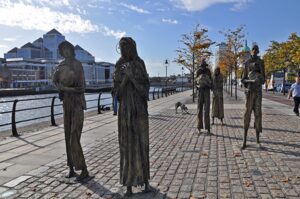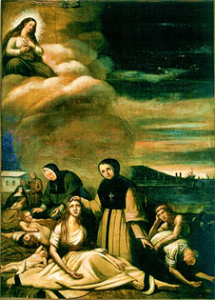St. Patrick’s Day, Irish Immigration and the Sisters of Providence
March 17 is St. Patrick’s Day, patron saint of Ireland who is considered the founder of Christianity in that country. In the 19th century, along with the United States, Australia and other countries linked to the British crown, Canada welcomed a massive influx of people from Ireland that were mainly escaping the Great Famine that was ravaging their country.
To mark this important date among the Irish community and highlight the participation of the Sisters of Providence lead by Emilie Gamelin we present:
The Great Irish Famine – The Canadian Component
Kevin Moynihan, film director and producer, has prepared a documentary about the Great Famine that devastated Ireland between 1845 and 1849. During this time, more than a million persons died directly from food shortages, especially of potatoes, and at least 800,000 more people immigrated to Canada.
This documentary sheds light on how these immigrants were received in Canadian territory, and the historical sites bearing witness to this large-scale disaster. In one section devoted to first responders, doctors, nurses, clergy and religious communities involved, it portrays the Sisters of Providence, guided by our foundress Émilie Tavernier-Gamelin. Its role in caring for thousands of Irish people, who were sick with typhus, endangering their own lives was paramount, and for that reason it is described as “heroic”. They also took in hundreds of orphans. It was the first major migration of refugees on Canadian soil.
The full version of the film is available in French and English. For those struggling to understand the storyline, we have prepared some guidelines before watching it:
 Historic Sites:
Historic Sites:
 The Celtic Cross, located on Grosse Île, Province of Quebec, National Historic Site of Canada – Irish Memorial. The monument and the entire park as well honor the memory of the Irish immigrants who were victims of typhus in 1847-1848 while commemorating their tragic fate during the Great Famine. Upon arriving to Canada, where immigrants were quarantined on the island, and more than 6,000 people of Irish background who were infected by typhus are buried here.
The Celtic Cross, located on Grosse Île, Province of Quebec, National Historic Site of Canada – Irish Memorial. The monument and the entire park as well honor the memory of the Irish immigrants who were victims of typhus in 1847-1848 while commemorating their tragic fate during the Great Famine. Upon arriving to Canada, where immigrants were quarantined on the island, and more than 6,000 people of Irish background who were infected by typhus are buried here.
During the summer of 1847, an impressive number of Irish immigrants arrived in Montreal, many of whom, had typhus too.
La Roche noire (Black Rock), a composition dedicated to the memory of more than 6000 people who were buried, as well as to the Montrealers who, in trying to help them, died of typhus themselves. This landmark is located below the Victoria Bridge, which connects Montreal to the South Shore of the St. Lawrence River.
 The sculptural ensemble The Arrival is in the Irish Park on the shores of Lake Ontario, across from downtown Toronto. This site was built to commemorate the life of more than 38,000 Irish people. who fleeing famine. arrived in Toronto in 1847, in search of a better life. More than 1,200 of them died during the typhus epidemic.
The sculptural ensemble The Arrival is in the Irish Park on the shores of Lake Ontario, across from downtown Toronto. This site was built to commemorate the life of more than 38,000 Irish people. who fleeing famine. arrived in Toronto in 1847, in search of a better life. More than 1,200 of them died during the typhus epidemic.
First Responders:
The painting “Typhus” by the artist Théophile Hamel depicts the great dedication of religious communities during the typhus epidemic. A Grey Nun, a Sister of Providence and a Sister Hospitaller of St. Joseph dedicated body and soul to the care of the sick, risking their own lives. Doctors, nurses, and priests lost their lives in fighting this terrible disease.
Follow this link to watch the documentary in full:
To learn more about the devoted implication of the Sisters of Providence in the great typhus epidemic in Montreal, you can watch this video (available only in French): https://www.facebook.com/Providenceintl1843/videos/133992870269078



